A Detailed Report: Leadership, Management, and Operations at Uber
VerifiedAdded on 2020/10/22
|11
|2868
|275
Report
AI Summary
This report provides a comprehensive analysis of leadership and management within Uber Technologies. It begins with an executive summary highlighting the importance of operational management in achieving company objectives. The report delves into the roles and characteristics of leaders and managers, differentiating between their responsibilities and functions. It explores various leadership theories, including situational, system, and contingency leadership, and illustrates their application within Uber's organizational context. The report also examines different approaches to operations management, emphasizing its value in business and the key external factors influencing it. Through this analysis, the report aims to provide a clear understanding of how effective leadership and management contribute to Uber's operational success. The report also includes a discussion on the similarities and differences between a leader and a manager, providing a detailed analysis of leadership and management theories, and their implementation in different organizational contexts. This research involves different leadership theories like contingency and systematic. Along with it, key approaches of leadership management and importance of operational management is mentioned.
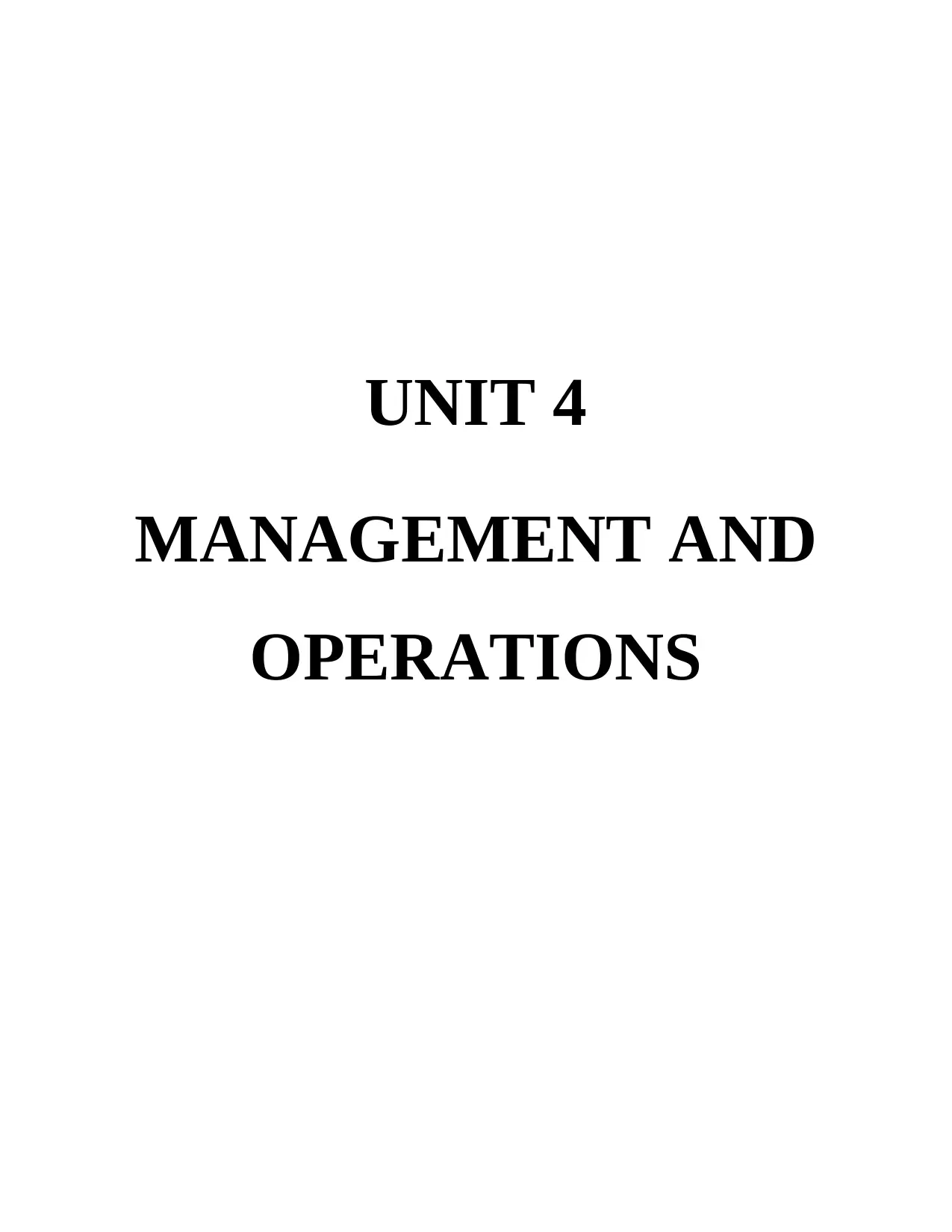
UNIT 4
MANAGEMENT AND
OPERATIONS
MANAGEMENT AND
OPERATIONS
Paraphrase This Document
Need a fresh take? Get an instant paraphrase of this document with our AI Paraphraser
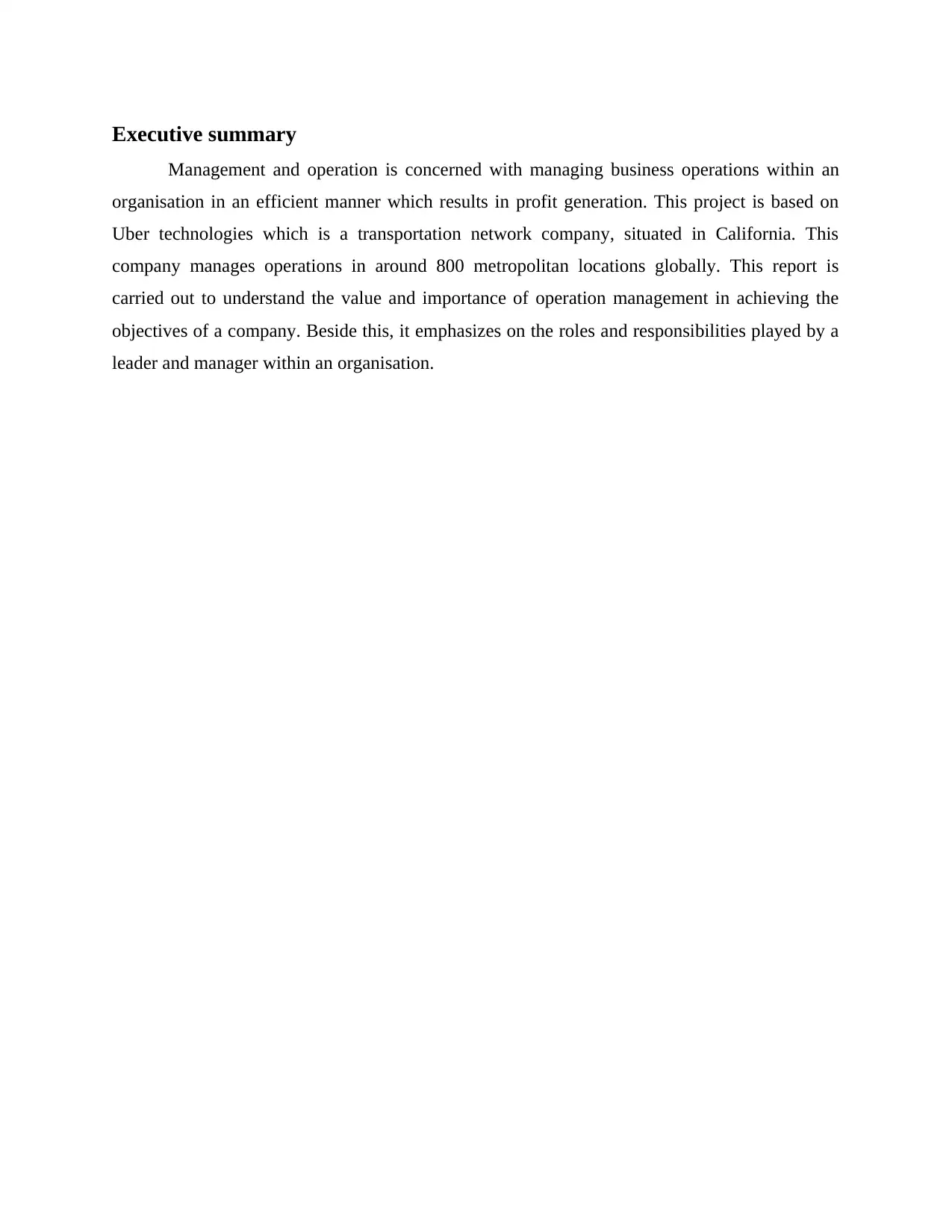
Executive summary
Management and operation is concerned with managing business operations within an
organisation in an efficient manner which results in profit generation. This project is based on
Uber technologies which is a transportation network company, situated in California. This
company manages operations in around 800 metropolitan locations globally. This report is
carried out to understand the value and importance of operation management in achieving the
objectives of a company. Beside this, it emphasizes on the roles and responsibilities played by a
leader and manager within an organisation.
Management and operation is concerned with managing business operations within an
organisation in an efficient manner which results in profit generation. This project is based on
Uber technologies which is a transportation network company, situated in California. This
company manages operations in around 800 metropolitan locations globally. This report is
carried out to understand the value and importance of operation management in achieving the
objectives of a company. Beside this, it emphasizes on the roles and responsibilities played by a
leader and manager within an organisation.

Table of Contents
Executive summary..........................................................................................................................2
INTRODUCTION ..........................................................................................................................1
ACTIVITY 1...................................................................................................................................1
P1 Differences and similarities between a leaders and manager considering their roles and
characteristics.........................................................................................................................1
P2 Role of a leader and functions of a manager apply in different organisational context...3
P3 Different theories and models of approach.......................................................................5
ACTIVITY 2...................................................................................................................................6
P4 Different approaches to operations management..............................................................6
P5 Importance and value of operations management in business..........................................6
P6. The key outside factors that can have an effect on the operations management.............7
CONCLUSION................................................................................................................................7
REFERENCES................................................................................................................................8
Executive summary..........................................................................................................................2
INTRODUCTION ..........................................................................................................................1
ACTIVITY 1...................................................................................................................................1
P1 Differences and similarities between a leaders and manager considering their roles and
characteristics.........................................................................................................................1
P2 Role of a leader and functions of a manager apply in different organisational context...3
P3 Different theories and models of approach.......................................................................5
ACTIVITY 2...................................................................................................................................6
P4 Different approaches to operations management..............................................................6
P5 Importance and value of operations management in business..........................................6
P6. The key outside factors that can have an effect on the operations management.............7
CONCLUSION................................................................................................................................7
REFERENCES................................................................................................................................8
⊘ This is a preview!⊘
Do you want full access?
Subscribe today to unlock all pages.

Trusted by 1+ million students worldwide

INTRODUCTION
Management and operation is concerned with planning, introducing, organising and
monitoring in context of production or provision of service. It emphasizes on successfully
turning inputs into outputs in an appropriate way. Operational management is associated with
logistics and supply chain management which is managed by managers and leaders within an
organisation. This present assignment is based on the context of Uber which is an America based
transportation company which provides taxi-cab, bicycle sharing and food delivery facilities. It is
situated in San Francisco, California. Services provided by company are assessed through mobile
applications and website Uber. This report includes role and functions of manager and leader
along with their similarities and differences. Beside this, managerial functions of a manager are
discussed. This research involves different leadership theories like contingency and systematic.
Along with it, key approaches of leadership management and importance of operational
management is mentioned.
ACTIVITY 1
P1 Differences and similarities between a leaders and manager considering their roles and
characteristics
Leader: Leaders are individuals which guides the workforce in an organisation by
implementing their leadership skills. A good leader has integrity, honesty and clear vision
regarding objectives and targets of the firm. An efficient leader is capable to manage all
employees within a team in an appropriate way. Leaders in Uber directs and guide the workforce
to carry out tasks within specified time.
Manager: A manager is an individual which manages a certain task or subset within an
organisation. Within a company, different managers execute their responsibilities in accordance
with their designated work. Manager in Uber provide knowledge and guidance to employees
which allow them to carry out business operations in an efficient manner.
Roles and characteristics of a leader:
Roles: A team leader serves different kinds of role within a company. Their main role is to carry
out tasks with the available resources in an optimised way. Main roles played by a leader within
an organisation is mentioned below:
1
Management and operation is concerned with planning, introducing, organising and
monitoring in context of production or provision of service. It emphasizes on successfully
turning inputs into outputs in an appropriate way. Operational management is associated with
logistics and supply chain management which is managed by managers and leaders within an
organisation. This present assignment is based on the context of Uber which is an America based
transportation company which provides taxi-cab, bicycle sharing and food delivery facilities. It is
situated in San Francisco, California. Services provided by company are assessed through mobile
applications and website Uber. This report includes role and functions of manager and leader
along with their similarities and differences. Beside this, managerial functions of a manager are
discussed. This research involves different leadership theories like contingency and systematic.
Along with it, key approaches of leadership management and importance of operational
management is mentioned.
ACTIVITY 1
P1 Differences and similarities between a leaders and manager considering their roles and
characteristics
Leader: Leaders are individuals which guides the workforce in an organisation by
implementing their leadership skills. A good leader has integrity, honesty and clear vision
regarding objectives and targets of the firm. An efficient leader is capable to manage all
employees within a team in an appropriate way. Leaders in Uber directs and guide the workforce
to carry out tasks within specified time.
Manager: A manager is an individual which manages a certain task or subset within an
organisation. Within a company, different managers execute their responsibilities in accordance
with their designated work. Manager in Uber provide knowledge and guidance to employees
which allow them to carry out business operations in an efficient manner.
Roles and characteristics of a leader:
Roles: A team leader serves different kinds of role within a company. Their main role is to carry
out tasks with the available resources in an optimised way. Main roles played by a leader within
an organisation is mentioned below:
1
Paraphrase This Document
Need a fresh take? Get an instant paraphrase of this document with our AI Paraphraser
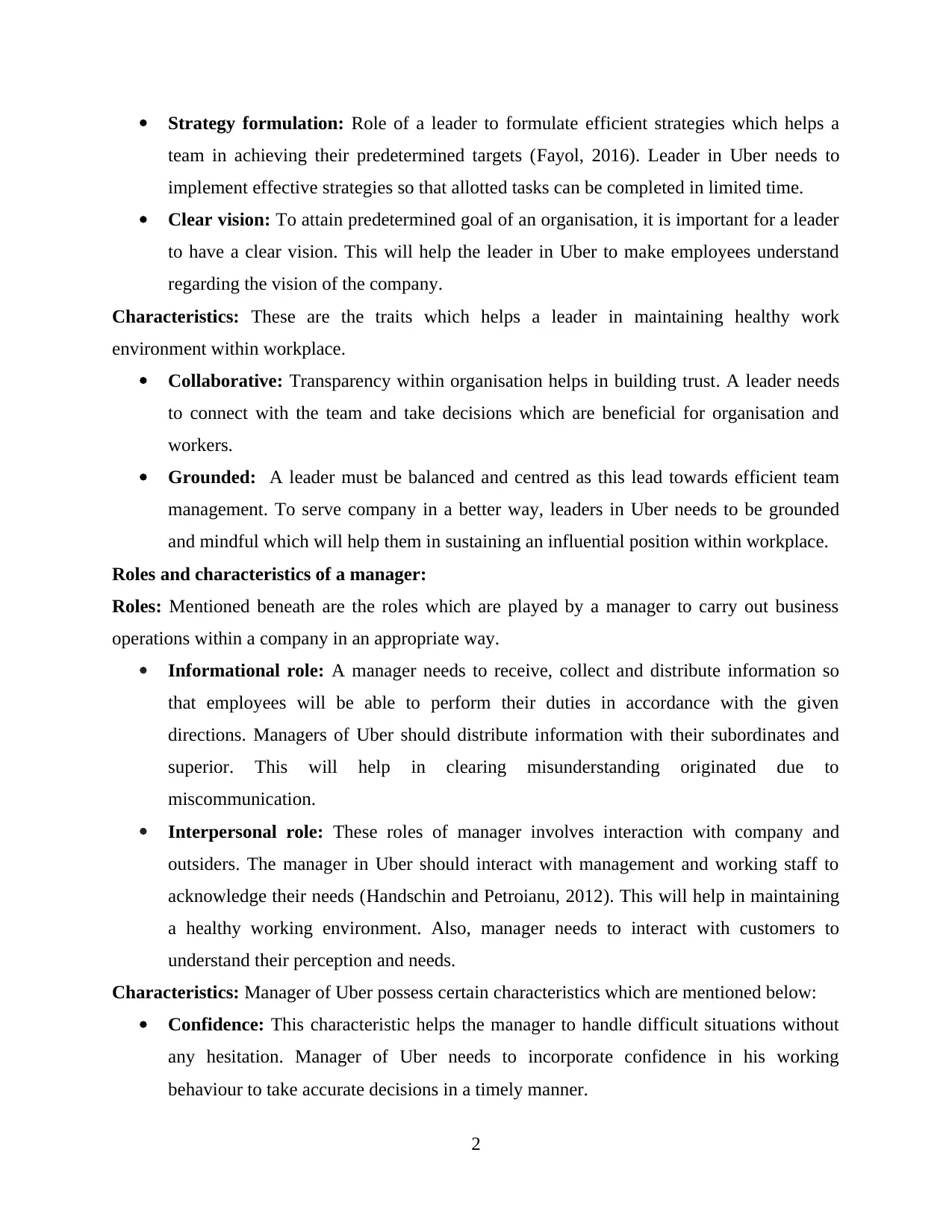
Strategy formulation: Role of a leader to formulate efficient strategies which helps a
team in achieving their predetermined targets (Fayol, 2016). Leader in Uber needs to
implement effective strategies so that allotted tasks can be completed in limited time.
Clear vision: To attain predetermined goal of an organisation, it is important for a leader
to have a clear vision. This will help the leader in Uber to make employees understand
regarding the vision of the company.
Characteristics: These are the traits which helps a leader in maintaining healthy work
environment within workplace.
Collaborative: Transparency within organisation helps in building trust. A leader needs
to connect with the team and take decisions which are beneficial for organisation and
workers.
Grounded: A leader must be balanced and centred as this lead towards efficient team
management. To serve company in a better way, leaders in Uber needs to be grounded
and mindful which will help them in sustaining an influential position within workplace.
Roles and characteristics of a manager:
Roles: Mentioned beneath are the roles which are played by a manager to carry out business
operations within a company in an appropriate way.
Informational role: A manager needs to receive, collect and distribute information so
that employees will be able to perform their duties in accordance with the given
directions. Managers of Uber should distribute information with their subordinates and
superior. This will help in clearing misunderstanding originated due to
miscommunication.
Interpersonal role: These roles of manager involves interaction with company and
outsiders. The manager in Uber should interact with management and working staff to
acknowledge their needs (Handschin and Petroianu, 2012). This will help in maintaining
a healthy working environment. Also, manager needs to interact with customers to
understand their perception and needs.
Characteristics: Manager of Uber possess certain characteristics which are mentioned below:
Confidence: This characteristic helps the manager to handle difficult situations without
any hesitation. Manager of Uber needs to incorporate confidence in his working
behaviour to take accurate decisions in a timely manner.
2
team in achieving their predetermined targets (Fayol, 2016). Leader in Uber needs to
implement effective strategies so that allotted tasks can be completed in limited time.
Clear vision: To attain predetermined goal of an organisation, it is important for a leader
to have a clear vision. This will help the leader in Uber to make employees understand
regarding the vision of the company.
Characteristics: These are the traits which helps a leader in maintaining healthy work
environment within workplace.
Collaborative: Transparency within organisation helps in building trust. A leader needs
to connect with the team and take decisions which are beneficial for organisation and
workers.
Grounded: A leader must be balanced and centred as this lead towards efficient team
management. To serve company in a better way, leaders in Uber needs to be grounded
and mindful which will help them in sustaining an influential position within workplace.
Roles and characteristics of a manager:
Roles: Mentioned beneath are the roles which are played by a manager to carry out business
operations within a company in an appropriate way.
Informational role: A manager needs to receive, collect and distribute information so
that employees will be able to perform their duties in accordance with the given
directions. Managers of Uber should distribute information with their subordinates and
superior. This will help in clearing misunderstanding originated due to
miscommunication.
Interpersonal role: These roles of manager involves interaction with company and
outsiders. The manager in Uber should interact with management and working staff to
acknowledge their needs (Handschin and Petroianu, 2012). This will help in maintaining
a healthy working environment. Also, manager needs to interact with customers to
understand their perception and needs.
Characteristics: Manager of Uber possess certain characteristics which are mentioned below:
Confidence: This characteristic helps the manager to handle difficult situations without
any hesitation. Manager of Uber needs to incorporate confidence in his working
behaviour to take accurate decisions in a timely manner.
2

Knowledge: Most important trait in managers is knowledge which benefits them in
conducting business operations effectively. In context with Uber, manager needs to have
proper knowledge regarding the projects. This will help the organisation in enhancing
their revenue and profit margins.
Similarities between manager and leader:
Both leader and manager hold an important position within an organisation. Though their
work responsibilities are different still they possess some similarities in their working behaviour.
Both manager and leader direct the workforce which enable them to conduct their business
operations in a proper way. Manager and leader in Uber are well skilled, knowledgeable and
capable to perform their duties which provides competitive advantage to the company against
rival organisations (Kamel and et. al., 2013).
Differences between leader and manager:
Leader Manager
Leaders influence their teams to acquire
a specific goal.
Manager manages the company and
take responsibility regarding direction,
control and planning.
Leader sets direction to accomplish
tasks.
Manager plans the ways in which
targets can be achieved.
Leader opts transformational style to
carry out business activities.
Manager adopts transactional style to
perform business operations.
Leader focuses on development and
growth
Manager focuses on attainment of
desired outcomes.
P2 Role of a leader and functions of a manager apply in different organisational context
Leaders and manager hold an important place within an organisation. To achieve targeted
results, it is important for top management in Uber to hire experienced and professional
managers and leaders which can handle work even in changing situations. To achieve desired
3
conducting business operations effectively. In context with Uber, manager needs to have
proper knowledge regarding the projects. This will help the organisation in enhancing
their revenue and profit margins.
Similarities between manager and leader:
Both leader and manager hold an important position within an organisation. Though their
work responsibilities are different still they possess some similarities in their working behaviour.
Both manager and leader direct the workforce which enable them to conduct their business
operations in a proper way. Manager and leader in Uber are well skilled, knowledgeable and
capable to perform their duties which provides competitive advantage to the company against
rival organisations (Kamel and et. al., 2013).
Differences between leader and manager:
Leader Manager
Leaders influence their teams to acquire
a specific goal.
Manager manages the company and
take responsibility regarding direction,
control and planning.
Leader sets direction to accomplish
tasks.
Manager plans the ways in which
targets can be achieved.
Leader opts transformational style to
carry out business activities.
Manager adopts transactional style to
perform business operations.
Leader focuses on development and
growth
Manager focuses on attainment of
desired outcomes.
P2 Role of a leader and functions of a manager apply in different organisational context
Leaders and manager hold an important place within an organisation. To achieve targeted
results, it is important for top management in Uber to hire experienced and professional
managers and leaders which can handle work even in changing situations. To achieve desired
3
⊘ This is a preview!⊘
Do you want full access?
Subscribe today to unlock all pages.

Trusted by 1+ million students worldwide
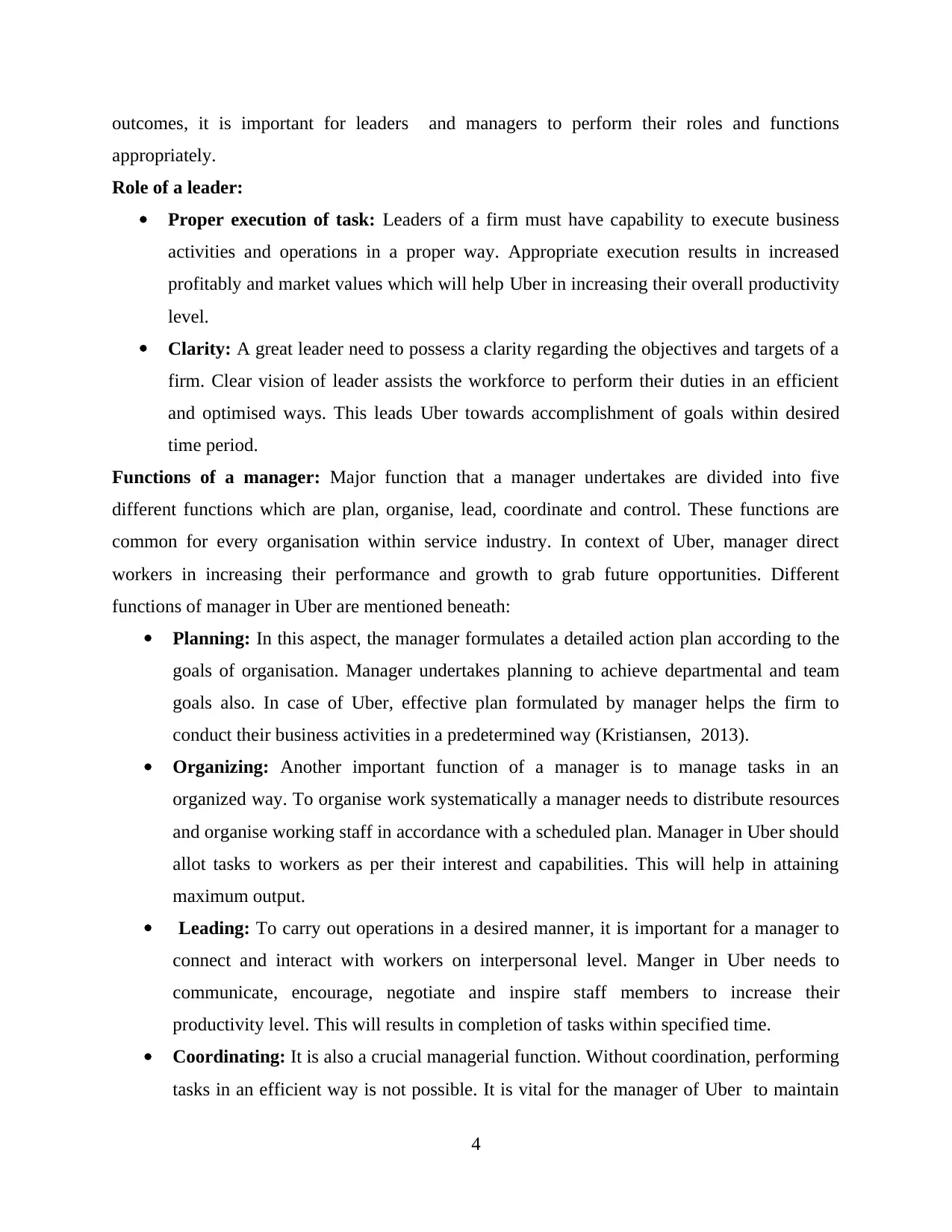
outcomes, it is important for leaders and managers to perform their roles and functions
appropriately.
Role of a leader:
Proper execution of task: Leaders of a firm must have capability to execute business
activities and operations in a proper way. Appropriate execution results in increased
profitably and market values which will help Uber in increasing their overall productivity
level.
Clarity: A great leader need to possess a clarity regarding the objectives and targets of a
firm. Clear vision of leader assists the workforce to perform their duties in an efficient
and optimised ways. This leads Uber towards accomplishment of goals within desired
time period.
Functions of a manager: Major function that a manager undertakes are divided into five
different functions which are plan, organise, lead, coordinate and control. These functions are
common for every organisation within service industry. In context of Uber, manager direct
workers in increasing their performance and growth to grab future opportunities. Different
functions of manager in Uber are mentioned beneath:
Planning: In this aspect, the manager formulates a detailed action plan according to the
goals of organisation. Manager undertakes planning to achieve departmental and team
goals also. In case of Uber, effective plan formulated by manager helps the firm to
conduct their business activities in a predetermined way (Kristiansen, 2013).
Organizing: Another important function of a manager is to manage tasks in an
organized way. To organise work systematically a manager needs to distribute resources
and organise working staff in accordance with a scheduled plan. Manager in Uber should
allot tasks to workers as per their interest and capabilities. This will help in attaining
maximum output.
Leading: To carry out operations in a desired manner, it is important for a manager to
connect and interact with workers on interpersonal level. Manger in Uber needs to
communicate, encourage, negotiate and inspire staff members to increase their
productivity level. This will results in completion of tasks within specified time.
Coordinating: It is also a crucial managerial function. Without coordination, performing
tasks in an efficient way is not possible. It is vital for the manager of Uber to maintain
4
appropriately.
Role of a leader:
Proper execution of task: Leaders of a firm must have capability to execute business
activities and operations in a proper way. Appropriate execution results in increased
profitably and market values which will help Uber in increasing their overall productivity
level.
Clarity: A great leader need to possess a clarity regarding the objectives and targets of a
firm. Clear vision of leader assists the workforce to perform their duties in an efficient
and optimised ways. This leads Uber towards accomplishment of goals within desired
time period.
Functions of a manager: Major function that a manager undertakes are divided into five
different functions which are plan, organise, lead, coordinate and control. These functions are
common for every organisation within service industry. In context of Uber, manager direct
workers in increasing their performance and growth to grab future opportunities. Different
functions of manager in Uber are mentioned beneath:
Planning: In this aspect, the manager formulates a detailed action plan according to the
goals of organisation. Manager undertakes planning to achieve departmental and team
goals also. In case of Uber, effective plan formulated by manager helps the firm to
conduct their business activities in a predetermined way (Kristiansen, 2013).
Organizing: Another important function of a manager is to manage tasks in an
organized way. To organise work systematically a manager needs to distribute resources
and organise working staff in accordance with a scheduled plan. Manager in Uber should
allot tasks to workers as per their interest and capabilities. This will help in attaining
maximum output.
Leading: To carry out operations in a desired manner, it is important for a manager to
connect and interact with workers on interpersonal level. Manger in Uber needs to
communicate, encourage, negotiate and inspire staff members to increase their
productivity level. This will results in completion of tasks within specified time.
Coordinating: It is also a crucial managerial function. Without coordination, performing
tasks in an efficient way is not possible. It is vital for the manager of Uber to maintain
4
Paraphrase This Document
Need a fresh take? Get an instant paraphrase of this document with our AI Paraphraser

effective coordination among employees which motivates them to work in a unified way.
Beside this, appropriate coordination among employees and management authorities will
create a positive and healthy work environment within the firm.
Controlling: Functions of a manager are not limited to above mentioned functions.
Manager needs to control and monitor the risk factors along with checking outcomes
related with accomplishment of goals. Manager of Uber needs to take corrective measure
in order to reduce risks and enhance profit margins and market shares.
Role of leader and manager in different situations:
Policy implementation: To manage business activities in an appropriate manner,
company needs to formulate several policies. Role of manager is to analyse the situation
and behaviour of employees regarding formulated policies. It is the duty of leader to
implement that policy after discussing with manager the possible outcomes associated
with it.
Decision making: It is a vital aspect within an organisation as correct decision results in
enhanced sales and revenues. All the important decisions related with company and
business activities are taken by leader. Manager take care of the outcomes that take place
due to that decision and inform leader if some issue is arising in the minds of employees
regarding that decision.
P3 Different theories and models of approach
Leader within a company adopts several theories and approaches which supports them in
acquiring their preset targets and conducting tasks in an efficient manner. Uber also undertakes
leadership approaches to execute their action and plan (Lindström and et. al., 2012). These
theories are discussed below:
Situational leadership: This theory is stated by Hersey and Blanchard. This model is
based upon the relation among leader and subordinates to analyse & identify different
conditions prevailed within organisation. Leader guides and direct the workforce to
perform duties in an appropriate way. This model is incorporated by Uber which helps
the senior member to take accurate decisions in changing situations. This benefits the
organisation along with catering the needs and demands of customers. For example,
Leader in Uber adopts this theory of leadership to take important decisions related with
tasks and projects. Decisions taken by leader must results in increased overall
5
Beside this, appropriate coordination among employees and management authorities will
create a positive and healthy work environment within the firm.
Controlling: Functions of a manager are not limited to above mentioned functions.
Manager needs to control and monitor the risk factors along with checking outcomes
related with accomplishment of goals. Manager of Uber needs to take corrective measure
in order to reduce risks and enhance profit margins and market shares.
Role of leader and manager in different situations:
Policy implementation: To manage business activities in an appropriate manner,
company needs to formulate several policies. Role of manager is to analyse the situation
and behaviour of employees regarding formulated policies. It is the duty of leader to
implement that policy after discussing with manager the possible outcomes associated
with it.
Decision making: It is a vital aspect within an organisation as correct decision results in
enhanced sales and revenues. All the important decisions related with company and
business activities are taken by leader. Manager take care of the outcomes that take place
due to that decision and inform leader if some issue is arising in the minds of employees
regarding that decision.
P3 Different theories and models of approach
Leader within a company adopts several theories and approaches which supports them in
acquiring their preset targets and conducting tasks in an efficient manner. Uber also undertakes
leadership approaches to execute their action and plan (Lindström and et. al., 2012). These
theories are discussed below:
Situational leadership: This theory is stated by Hersey and Blanchard. This model is
based upon the relation among leader and subordinates to analyse & identify different
conditions prevailed within organisation. Leader guides and direct the workforce to
perform duties in an appropriate way. This model is incorporated by Uber which helps
the senior member to take accurate decisions in changing situations. This benefits the
organisation along with catering the needs and demands of customers. For example,
Leader in Uber adopts this theory of leadership to take important decisions related with
tasks and projects. Decisions taken by leader must results in increased overall
5
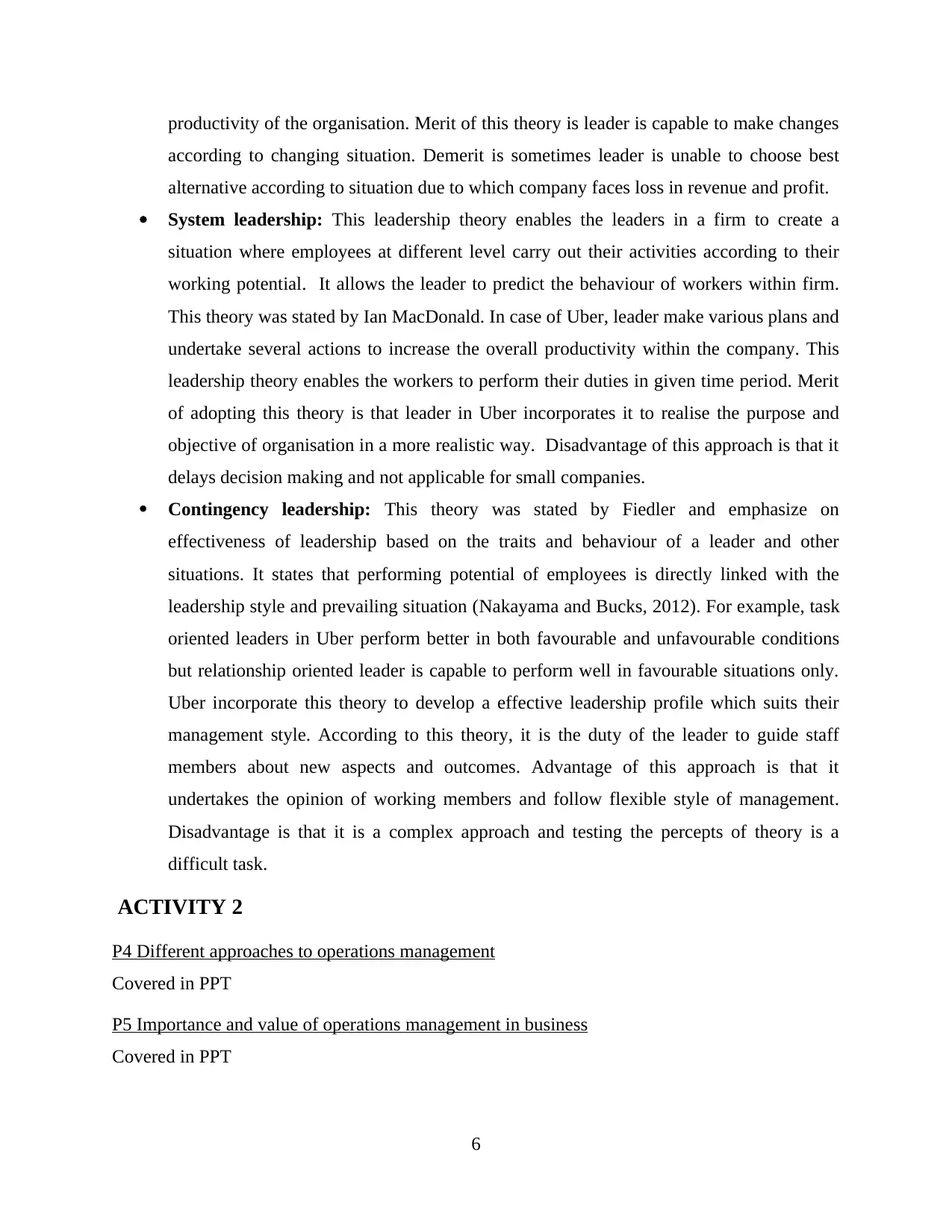
productivity of the organisation. Merit of this theory is leader is capable to make changes
according to changing situation. Demerit is sometimes leader is unable to choose best
alternative according to situation due to which company faces loss in revenue and profit.
System leadership: This leadership theory enables the leaders in a firm to create a
situation where employees at different level carry out their activities according to their
working potential. It allows the leader to predict the behaviour of workers within firm.
This theory was stated by Ian MacDonald. In case of Uber, leader make various plans and
undertake several actions to increase the overall productivity within the company. This
leadership theory enables the workers to perform their duties in given time period. Merit
of adopting this theory is that leader in Uber incorporates it to realise the purpose and
objective of organisation in a more realistic way. Disadvantage of this approach is that it
delays decision making and not applicable for small companies.
Contingency leadership: This theory was stated by Fiedler and emphasize on
effectiveness of leadership based on the traits and behaviour of a leader and other
situations. It states that performing potential of employees is directly linked with the
leadership style and prevailing situation (Nakayama and Bucks, 2012). For example, task
oriented leaders in Uber perform better in both favourable and unfavourable conditions
but relationship oriented leader is capable to perform well in favourable situations only.
Uber incorporate this theory to develop a effective leadership profile which suits their
management style. According to this theory, it is the duty of the leader to guide staff
members about new aspects and outcomes. Advantage of this approach is that it
undertakes the opinion of working members and follow flexible style of management.
Disadvantage is that it is a complex approach and testing the percepts of theory is a
difficult task.
ACTIVITY 2
P4 Different approaches to operations management
Covered in PPT
P5 Importance and value of operations management in business
Covered in PPT
6
according to changing situation. Demerit is sometimes leader is unable to choose best
alternative according to situation due to which company faces loss in revenue and profit.
System leadership: This leadership theory enables the leaders in a firm to create a
situation where employees at different level carry out their activities according to their
working potential. It allows the leader to predict the behaviour of workers within firm.
This theory was stated by Ian MacDonald. In case of Uber, leader make various plans and
undertake several actions to increase the overall productivity within the company. This
leadership theory enables the workers to perform their duties in given time period. Merit
of adopting this theory is that leader in Uber incorporates it to realise the purpose and
objective of organisation in a more realistic way. Disadvantage of this approach is that it
delays decision making and not applicable for small companies.
Contingency leadership: This theory was stated by Fiedler and emphasize on
effectiveness of leadership based on the traits and behaviour of a leader and other
situations. It states that performing potential of employees is directly linked with the
leadership style and prevailing situation (Nakayama and Bucks, 2012). For example, task
oriented leaders in Uber perform better in both favourable and unfavourable conditions
but relationship oriented leader is capable to perform well in favourable situations only.
Uber incorporate this theory to develop a effective leadership profile which suits their
management style. According to this theory, it is the duty of the leader to guide staff
members about new aspects and outcomes. Advantage of this approach is that it
undertakes the opinion of working members and follow flexible style of management.
Disadvantage is that it is a complex approach and testing the percepts of theory is a
difficult task.
ACTIVITY 2
P4 Different approaches to operations management
Covered in PPT
P5 Importance and value of operations management in business
Covered in PPT
6
⊘ This is a preview!⊘
Do you want full access?
Subscribe today to unlock all pages.

Trusted by 1+ million students worldwide
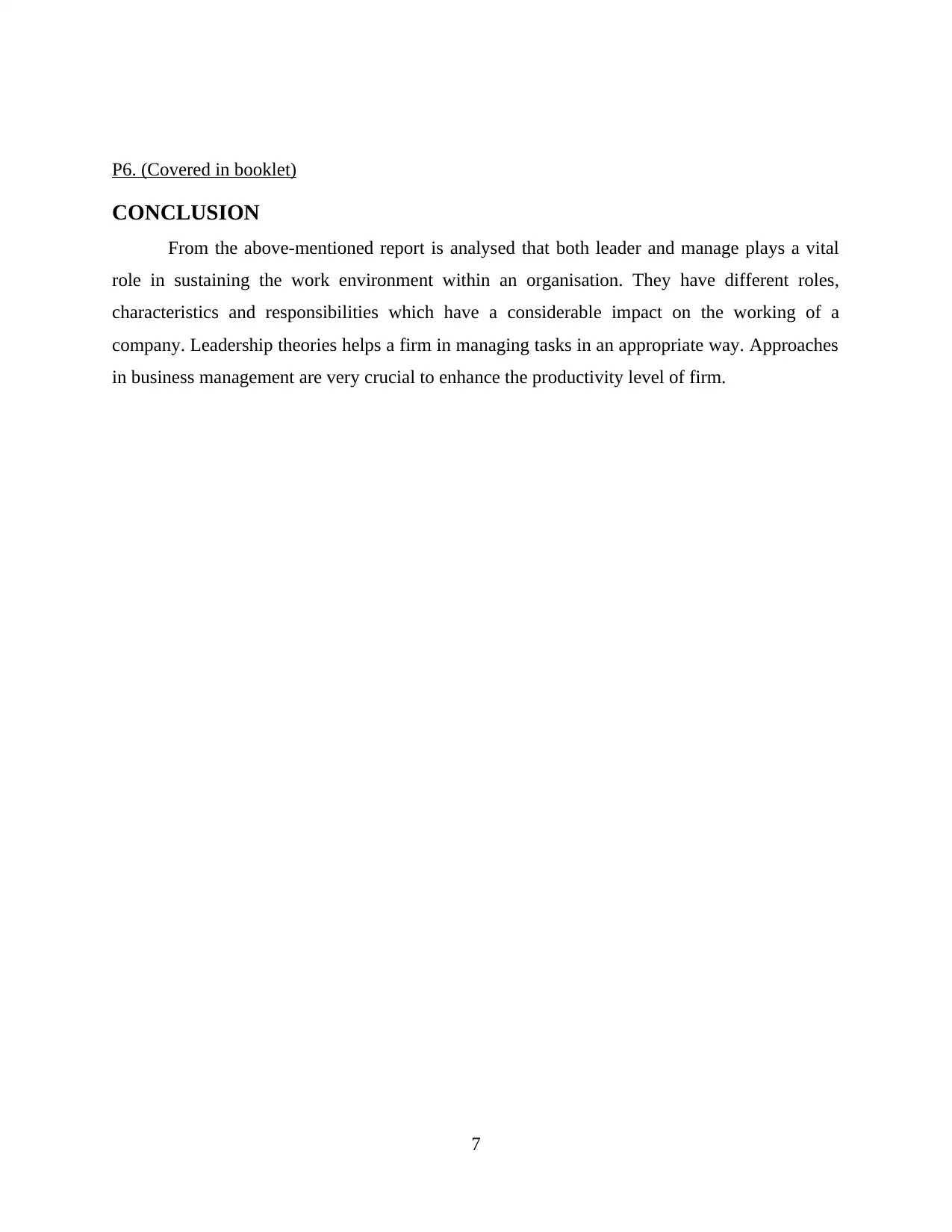
P6. (Covered in booklet)
CONCLUSION
From the above-mentioned report is analysed that both leader and manage plays a vital
role in sustaining the work environment within an organisation. They have different roles,
characteristics and responsibilities which have a considerable impact on the working of a
company. Leadership theories helps a firm in managing tasks in an appropriate way. Approaches
in business management are very crucial to enhance the productivity level of firm.
7
CONCLUSION
From the above-mentioned report is analysed that both leader and manage plays a vital
role in sustaining the work environment within an organisation. They have different roles,
characteristics and responsibilities which have a considerable impact on the working of a
company. Leadership theories helps a firm in managing tasks in an appropriate way. Approaches
in business management are very crucial to enhance the productivity level of firm.
7
Paraphrase This Document
Need a fresh take? Get an instant paraphrase of this document with our AI Paraphraser

REFERENCES
Books and Journals
Drucker, P., 2012. Management challenges for the 21st century. Routledge.
Fayol, H., 2016. General and industrial management. Ravenio Books.
Handschin, E. and Petroianu, A., 2012. Energy management systems: operation and control of
electric energy transmission systems. Springer Science & Business Media.
Kamel, M. and et. al., 2013. Optimal management and operation of a hybrid energy system based
on wind energy units. Journal of Electrical Systems. 9(2). pp.191-202.
Kristiansen, S., 2013. Maritime transportation: safety management and risk analysis. Routledge.
Lindström and et. al., 2012. A development process for Functional Products: hardware, software,
service support system and management of operation. International Journal of Product
Development. 16(3-4). pp.284-303.
Nakayama, F. S. and Bucks, D. A. Eds., 2012. Trickle irrigation for crop production: design,
operation and management (Vol. 9). Elsevier.
Nong, L. and et. al., 2013. Effects of parecoxib on morphine analgesia after gynecology tumor
operation: a randomized trial of parecoxib used in postsurgical pain management.
journal of surgical research. 183(2). pp.821-826.
Peng, C. and et. al., 2015. Uncertainty management in power system operation. CSEE Journal of
Power and Energy Systems. 1(1). pp.28-35.
Rushton, A., Croucher, P. and Baker, P., 2014. The handbook of logistics and distribution
management: Understanding the supply chain. Kogan Page Publishers.
Sedaghati, R. and Kavousi-Fard, A., 2014. A hybrid fuzzy-PEM stochastic framework to solve
the optimal operation management of distribution feeder reconfiguration considering
wind turbines. Journal of Intelligent & Fuzzy Systems. 26(4). pp.1711-1721.
Wu, B., 2012. Manufacturing and supply systems management: a unified framework of systems
design and operation. Springer Science & Business Media.
Xu, L. and wet. al., 2012. Real time optimal energy management strategy targeting at minimizing
daily operation cost for a plug-in fuel cell city bus. international journal of hydrogen
energy. 37(20). pp.15380-15392.
8
Books and Journals
Drucker, P., 2012. Management challenges for the 21st century. Routledge.
Fayol, H., 2016. General and industrial management. Ravenio Books.
Handschin, E. and Petroianu, A., 2012. Energy management systems: operation and control of
electric energy transmission systems. Springer Science & Business Media.
Kamel, M. and et. al., 2013. Optimal management and operation of a hybrid energy system based
on wind energy units. Journal of Electrical Systems. 9(2). pp.191-202.
Kristiansen, S., 2013. Maritime transportation: safety management and risk analysis. Routledge.
Lindström and et. al., 2012. A development process for Functional Products: hardware, software,
service support system and management of operation. International Journal of Product
Development. 16(3-4). pp.284-303.
Nakayama, F. S. and Bucks, D. A. Eds., 2012. Trickle irrigation for crop production: design,
operation and management (Vol. 9). Elsevier.
Nong, L. and et. al., 2013. Effects of parecoxib on morphine analgesia after gynecology tumor
operation: a randomized trial of parecoxib used in postsurgical pain management.
journal of surgical research. 183(2). pp.821-826.
Peng, C. and et. al., 2015. Uncertainty management in power system operation. CSEE Journal of
Power and Energy Systems. 1(1). pp.28-35.
Rushton, A., Croucher, P. and Baker, P., 2014. The handbook of logistics and distribution
management: Understanding the supply chain. Kogan Page Publishers.
Sedaghati, R. and Kavousi-Fard, A., 2014. A hybrid fuzzy-PEM stochastic framework to solve
the optimal operation management of distribution feeder reconfiguration considering
wind turbines. Journal of Intelligent & Fuzzy Systems. 26(4). pp.1711-1721.
Wu, B., 2012. Manufacturing and supply systems management: a unified framework of systems
design and operation. Springer Science & Business Media.
Xu, L. and wet. al., 2012. Real time optimal energy management strategy targeting at minimizing
daily operation cost for a plug-in fuel cell city bus. international journal of hydrogen
energy. 37(20). pp.15380-15392.
8
1 out of 11
Related Documents
Your All-in-One AI-Powered Toolkit for Academic Success.
+13062052269
info@desklib.com
Available 24*7 on WhatsApp / Email
![[object Object]](/_next/static/media/star-bottom.7253800d.svg)
Unlock your academic potential
Copyright © 2020–2025 A2Z Services. All Rights Reserved. Developed and managed by ZUCOL.





